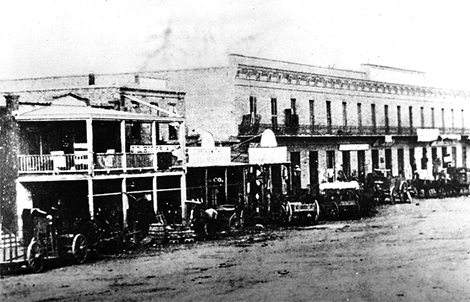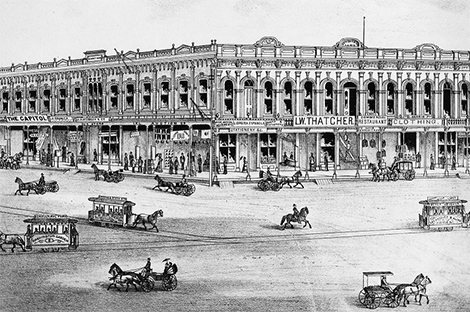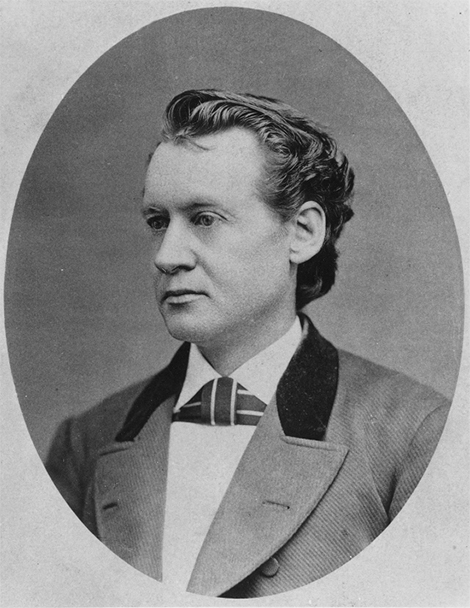This post is the first in a series of excerpts serializing the book Feels Like Home: Reflections on Central Library: Photographs From the Collection of Los Angeles Public Library (2018). Feels Like Home is a tribute to Central Library and follows the history from its origins as a mere idea to its phoenix-like reopening in 1993. As more fully described in this LAPL Reads review, Feels Like Home was part of Central 25, the 25th-anniversary celebration of the reopening after the ravages of the 1986 fire. Published by Photo Friends of the Los Angeles Public Library, it features both researched historical accounts and first-person remembrances.
Feels Like Home was designed by Amy Inouye of Photo Friends, who was awarded the 2019 Bruckman Rare Book Friends Award for the book’s design and publication. The Senior Librarian of the Photo Collection, Christina Rice, was awarded the 2019 Bruckman Rare Book Friends Angel Award for her role in leading the Central 25 Celebration and was the driving force behind the book, edited by her, Sheryn Morris, and James Sherman. The book can be purchased through the Library Foundation of Los Angeles Bookstore.
Chapter 1
"A Wanderer and Homeless Waif": Los Angeles’ Central Library - part 1 by Glenna Dunning, Former Librarian, History & Genealogy Department
Planning and maintaining a library to serve the needs of the reading public is not new to Los Angeles. As early as 1844 a society called Los Amigos del País organized "a social gathering place" where books and magazines could be read. Located in Amigos Hall on North Main Street near the Plaza, the library consisted of a small reading-room with a few tables, chairs, and books, and magazines which had been donated by public spirited citizens. Newspapers from "the States" were especially prized, even if they arrived more than six months late. Within a year or two, however, interest in the reading room diminished and the society, saddled with growing debt, put the property up for sale in a lottery. General Andres Pico, brother of Governor Pio Pico, drew the lucky number and acquired the building, furniture, and all reading materials.
In 1856 "The Mechanics Institute" (named after the organization in San Francisco) established a reading room in a corrugated iron building on the south-east corner of North Spring and Court streets. It offered a small collection of reading materials but received little financial support and closed its doors in 1858.
It wasn't long after the Institute's reading room folded that several civic-minded residents began an organized campaign to establish a public library. On April 2, 1859, the Los Angeles Star ran the announcement "All who are disposed to aid in establishing a Library and Reading Room in the city are requested to meet at Wells, Fargo and Company's Express Office, on Monday evening, April 4, 1859, at 7 o'clock." This meeting proved a success and, on July 11, a group of prominent businessmen, including Felix Bachman, Myer J. Newmark, and William H. Workman organized the Library Association and elected John Temple as President. The Association immediately appointed committees to solicit memberships, gifts, and subscriptions, and to secure and furnish library quarters. The Los Angeles Star proclaimed "We are glad to know that the endeavor to establish a Library and Reading Room in this City is likely to prove successful. An adjourned meeting was held Thursday evening at which the constitution and by-laws were adopted."

The Library Association located suitable quarters in businessman Abel Stearns’ Arcadia Block on Los Angeles Street and, on September 15, 1859, the new Los Angeles Library opened its doors. On September 24, the Star announced that "The Library Association rooms are now open, and are supplied with all the leading periodicals and papers, not only of the State but of the Union. Such an institution has long been desired here, and now the want is supplied. We hope the citizens of all classes will rally to its support. The rooms are comfortably fitted up and nowhere can one spend a leisure hour more profitably than by availing himself of the privileges of the Library. The terms of subscription are within reach of all and we hope to see a large list of subscribers." At the time many libraries were not free to the public and charged subscription fees for use of the facilities. Los Angeles was no exception, the Library Association charging five dollars as an initiation fee and monthly dues of one dollar.
Many citizens donated books, magazines, and money to support the Library. Los Angeles Mayor Henry Mellus, who sailed with Richard Henry Dana on the voyage immortalized in Two Years Before the Mast contributed his personal collection of books, and employees of the Overland Mail pledged that newspapers of California, the Eastern states, and the "Northern Frontier" would be collected on various stage routes and delivered to the Library as quickly as possible.
The Library flourished for a time, becoming "an attractive resort for the residents, as well as for strangers visiting the city" and it was there that Mayor Mellus welcomed Governor John Downey on his first official visit to Los Angeles. However, in spite of its strong beginning, public support of the Library, for a variety of reasons, began to wane. Perhaps the subscription fees were too expensive, or the delay in receiving Eastern newspapers, coupled with the scarcity of new books, proved to be a frustrating annoyance but, for whatever reason, the "project, to the regret of many, had to be abandoned" and the Library Association died out by the start of the Civil War.
For more than a decade, the growing city was without a public library. The desire for books was evident as some local merchants displayed small collections of books and periodicals, or even provided small circulating libraries which they advertised in local newspapers. Nevertheless, several prominent citizens viewed the lack of a public library as a community disgrace and embarrassment. This opinion was mirrored in a Los Angeles Star editorial of December 5, 1872, which stated that "the absence of a place where a cultivated person may go for books of reference or standard library works has been spoken of to our injury abroad.”
Possibly in response to that editorial, "another agitation" for a public library led to a meeting on December 7, 1872, in the old Merced Theatre on Main Street where more than two hundred citizens turned out in support of a city library. As a result, another Library Association was established, led by Governor John Downey, H.K.W. Bent, and Harris Newmark. They were appointed to a committee which would "canvass the city for subscriptions, donations of books, and to take such other steps as they may deem proper until the next meeting." The subscription form presented to potential supporters stated that "The undersigned, with the view of establishing a public library in the city of Los Angeles, do hereby become members of the Los Angeles Library Association, and agree to pay the sums set opposite our names as donations, entrance fees, or for life membership as specified." The life membership fee was $50 and the annual fee was $5.
At a subsequent meeting on December 14, the committee reported that they had signed up one hundred and fifty members (including nine life members), had secured donations amounting to four hundred dollars, and had received numerous gifts of books. They also found a home for the new library when Governor Downey offered free rent for the first three months if the Library would move into a two-room "suite" in his newly constructed Downey Block, the monthly rent to be $40.00 after that.
Located on the comer of Temple and Spring streets, the two-story Downey Block was described by the Los Angeles Daily News as "the most imposing" brick building in the city, all offices "arranged in suit[e]s, and furnished with gas and water." The Library would share the upper floor with such established neighbors as Ganahl & McDaniel, lawyers; R. M. Widney, lawyer and real estate dealer; the doctors Richardson, Edgar, and Door; Dr. Crawford, dentist; Nichols & Smith, real estate dealers; and George Pridham, saloon keeper.

In January 1873 the Los Angeles Library opened to the public. It was comprised of two reading rooms furnished with tables, newspaper racks, and shelves filled with approximately 750 volumes, ranging from literary classics to books on history, travel, and fiction. A smaller adjoining room had tables set up for checkers and chess and early records show that it was as popular with the public as the main reading room.
We can get a detailed description of the library from the recollections of early pioneer William Andrew Spalding. In a meeting of the Southern California Historical Society, he related that
" ... the Library as I first saw it, was housed in two rooms [in the Downey Block]. The front and principal room was probably twenty by thirty feet in floor dimensions and was fairly lighted by two large windows looking out upon Main Street to the southeast. Back of this, shut off by a half-high partition, was the smaller room-probably twelve by twenty feet-which was used for storage and other general purposes, and a portion set off for chess and checkers. This last equipment consisted of a plain pine table and half a dozen chairs...The main room of the Library at the head of the stairs was lighted by two front windows, and along the two side walls were the bookshelves. I make a guess that they contained fifteen hundred or two thousand volumes. These were mainly the books that had been loaned or given by citizens, as the Library was not sufficiently endowed to indulge in the extravagance of new books. In the center of the room were two or three ample tables upon which reposed late copies of the few principal magazines of that day: Harper's Monthly, The Galaxy, The Atlantic-Harper's, and Frank Leslie's Weekly, Bonner's New York Ledger, the Waverly, and files of the daily and weekly papers of Los Angeles City and County, and of San Francisco. At that time we considered it a noble array. I know that John Littlefield, the Librarian, was very proud of this showing that the Los Angeles Public Library was right up to date."
John Littlefield, former editor of the Weekly Express, had been hired as the first City Librarian at a salary of $75 per month. He labored ceaselessly to fulfill his responsibilities, spending much of his time tramping around the city seeking financial backing from those who had made a pledge of support. Littlefield was a victim of chronic asthma and, at the first sign of a cough, he would retire to a little room in the rear of the Library where he filled his
pipe with dried jimson leaves which he smoked for relief of his symptoms. The smoke may have helped the librarian but did little for the patrons, and it was reported that "the abominable fumes of the burning [leaves] permeated the whole establishment and nearly choked everybody in it. Patrons of high strung temperament generally retired at the first asthmatic signal."
In spite of Littlefield's health problems, he worked hard to improve the Library and its collection. On May 1, 1873, an article in the Evening Express recognized his efforts by boasting "We have today the finest Library and the completest [sic] in all its detail and appointments of any in the State south of San Francisco-a delightfully popular resort, which is at once the pride and honor of our city." Indeed, the article announced, the Library had "volumes on the shelves ranging from standards in literature to books of history, travel, and fiction. On the tables were the important American and English monthlies, and at least twenty daily newspapers and ten weekly papers were provided.”

Ladies were becoming active in the use and support of the Library. Although they were not able to obtain their own library cards, "the ladies of Los Angeles had begun to frequent the Library, using the membership cards of the masculine members of the family (for the original membership had been 'men only')." In 1876 a ladies' reading room was added, "pleasantly furnished and equipped with tables, books, and magazines.”
Support of the Library became an interest and activity for several members of Los Angeles' high society. In 1877, for example, the Library's "constant growth and increasing demands suggested to Mrs. S. B. Caswell the idea of giving a ball for the benefit of the library fund. This was the first entertainment given for this purpose. It took place in June 1877, in the old Tumverein Hall ... and proved a decided success, netting $220 for the purchase of books." Other balls and "entertainments" followed, including The Dickens Party, "a social event that will be remembered for the lifetime of the elder generation." Enough funds were raised at an 1880 Dickens Party that $250 of the proceeds was donated to the library.
In 1879 the City Council passed an ordinance establishing the "Los Angeles Public Library" and making it a department of the city. Los Angeles assumed responsibility for the library's financial support, and the Library Association surrendered its authority to a new Board of Regents appointed by the Mayor.
Glenna Dunning (1947-2015)
In the History & Genealogy Department at Central Library, Glenna Dunning was the go-to librarian with questions relating to really early Los Angeles history and was able to keep all those adobes and ranchos straight. If some aspect of Los Angeles history piqued her interest, it wasn’t long before an article she penned on the subject showed up in the Los Angeles City Historical Society Newsletter. Glenna’s many historical writings are cited in the library’s California Index and serve as a tangible reminder of the dedicated librarian who served her beloved city well. A fully cited version of “A Wanderer & Homeless Waif” is available on request.
